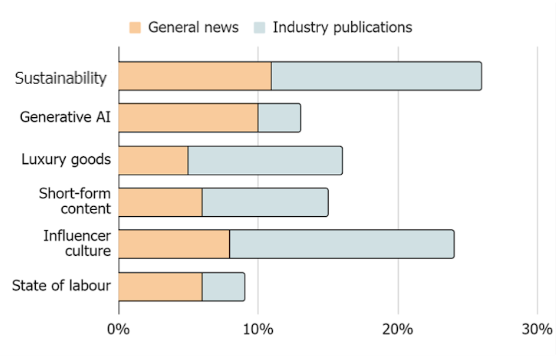Tax cuts and fiscal headroom
Jeremy Hunt has been facing renewed calls from Conservative colleagues to cut taxes after new figures from the Resolution Foundation revealed that Government revenues had increased by an estimated £15bn this year. The Chancellor is now expected to have £13bn of fiscal headroom, double the £6.5bn he allowed for at the March budget.
Despite this, the Foundation cautions that this level of headroom is a ‘fiscal illusion’ and that higher inflation would eventually feed public spending too. Similarly, the National Institute of Economic and Social Research said that the Chancellor’s priority for the Autumn Statement should be investment in the economy rather than tax cuts ahead of the election.
On the other hand, the Growth Commission, set up by Liz Truss, insisted that we need to reverse
stagnating UK living standards and stated “If we carry on the same way, we are likely to [see] rising taxes [and continue to] pay for ever growing public spending.”
The commission proposed:
• Cutting corporation tax from 25% to 15%
• Unfreezing tax allowances
• Abolishing inheritance tax and stamp duty
• Imposing more stringent requirements for benefits and freezing the minimum wage
• “Use it or lose it” time limits on planning permission
• Cutting the time taken to approve big transport and energy projects by 75%
• Ending the ban on fracking
• Scrapping net zero levies
Labour’s shadow chief secretary to the Treasury Darren Jones said: ‘Liz Truss and her backers in the
Conservative Party are once again pushing the policies that crashed the economy last year and left working people worse off, with higher prices and mortgage bills.’, while the Treasury declines to comment.
Over the past few weeks, Treasury sources have highlighted the risk of fuelling inflation and insisted the Chancellor will take a cautious approach. Jeremy Hunt has downplayed expectations of any big giveaways ahead of the Autumn Statement saying his priority is to steady the ship and cut inflation.
It is rumoured that any major fiscal measures are getting pushed back to the Spring Budget, closer to the general election.
Inheritance tax cut and abolition
Despite the Government insisting repeatedly that tax cuts are not currently on the table, there have been rumours about possible changes to inheritance tax (IHT). Around 50 MPs have called for it to be abolished, however, as the IHT currently pockets the Government around £7bn a year, it is possible that the Chancellor may open a consultation on reform, to lay the ground for a future announcement at the Spring Budget or as a General Election manifesto pledge.
Business
Moreover, since the figures on the fiscal headroom have been released, the Daily Mail reported that the Chancellor is mulling over a £10bn extension of a temporary tax break that rewards firms for investing in their businesses. The CBI has been pushing for an extension to full capital expensing beyond the current 3-year window; they show that the move could deliver a permanent boost of 21% to business investment and increase GDP by up to 2% by 2030/31.
To help businesses, the Federation of Small Businesses (FSB), alongside other industry groups, have been calling for the 75% business rates relief for small hospitality, retail and leisure firms in England to stay in place past its March expiry date, warning of the devastating consequences if letting it expire.
The FSB also recommends the Government take decisive action to incentivise employers recruiting those who have been out of work for a long time. Moreover, to kickstart a new era of skills development, FSB is calling on the Government to make training for new skills tax-deductible for the self-employed as part of its Autumn Statement plan.
Lord Harrington’s review into how the UK can better attract foreign direct investment into key growth sectors was due in September and businesses will be keen to see the findings of how the Government is going to respond.
Tax thresholds
The 2022 Autumn Statement announced the freezing of various tax thresholds, however, with an election looming in the not too distant future, it is possible that the Chancellor could revisit the timescales for the thresholds.
ISA changes
Savers are currently restricted to opening and putting money in just one of each type of ISA a year.
However, it seems like Jeremy Hunt will use the Autumn Statement to announce an ISA shake-up that will allow savers to open multiple Isas of the same type in a single tax year without losing their £20,000 allowance.
This would be a relatively minor change compared to the ISA overhaul that seemed to be on the cards until a few days ago. While it seemed like Jeremy Hunt was planning to give savers an extra £5,000 ISA allowance to invest in British stocks, The Telegraph reports that this plan has been abandoned. Moreover, while Martin Lewis called for ISA reforms to help first-time homebuyers this week, The Telegraph reports that the Chancellor does not plan to lift the Lifetime ISA limit or scrap the penalty charge for savers who breach it.
All in all, it is expected that a consultation into wider ISA reforms will be announced at the Autumn
Statement.
Financial advice
The Government is expected to release a consultation on reforms to address the boundary between
regulated advice and guidance in the autumn – potentially as part of the Autumn Statement.
Energy & Environment
Energy prices
The energy price cap was introduced by the Government and has been in place since January 2019; Ofgem is required to regularly review the level at which it is set. It ensures that an energy supplier can recoup its efficient costs while making sure customers do not pay a higher amount for their energy than they should.
Last month, Reuters reported that Ofgem was considering a one-off increase to its price cap on energy bills to reduce the risk of suppliers going bust, amid record levels of customer energy debt. This could mean bills will rise again but Ofgem said this wouldn’t be until April 2024.
In an open letter backed by MoneySavingExpert and its founder Martin Lewis – a coalition of 140 charities, consumer groups and MPs called for urgent action to introduce a social tariff for energy.
NFU President Minette Batters sent a letter to Chancellor Jeremy Hunt, outlining the pressure points on farming businesses; as well as fertiliser and energy costs, farmers are also facing cuts to direct support payments while new support schemes are yet to offer similar levels of support. The NFU has called on the Treasury to: review long-term energy contracts in the commercial sector; remove the uncertainty over the tax treatment of agricultural land entered into environmental schemes; and lead a cross-government taskforce to ensure the regulation and oversight of the UK’s environmental markets.
Measures for automotive industry
According to BDO’s Budget Predictions, the EU Carbon Border Adjustment Mechanism (CBAM), which took effect from 1 October, will affect some UK importers going forward. The UK has consulted on creating its own carbon leakage tax and, although we can expect feedback on the proposals, it may yet be some time before it imposes new reporting burdens and taxes on importing companies. Extending the exemption from 10% import duty for electric car batteries (currently due to expire on 31 December 2023) may also prove to be on the agenda if the government has not completely given up on its plans to reach net zero; it would also remove a potentially inflationary measure.
MHA’s budget ‘wishlist’ also stated that a key area for the Government to look at is the VAT charge on public charging. Partner at MHA, Alastair Cassel comments, “Despite the recent PM statement regarding a delay to the banning of selling new ICE vehicles, the ZEV mandate remains unaltered in its mission to drive an acceleration to EV adoption. This means that EVs have to be made more attractive to buyers and in particular private buyers. We have significant investment being made in charge points and a reduction in VAT to parity with the domestic electricity rate of 5% would help with the total cost of ownership cast and also would continue to encourage further infrastructure investment.”
Additionally, Mike Hawes, Chief Executive of SMMT, said: “With demand for new cars surpassing prepandemic levels, the market is defying expectations and driving growth. As fleet uptake flourishes, particularly for EVs, sustained success depends on encouraging all consumers to invest in the latest zero emission vehicles. The Autumn Statement is a key opportunity for [the] Government to introduce incentives and facilitate infrastructure investment. Doing so would send a clear signal of support for drivers, reassuring them that now is the time to switch to electric.”
Green tax measures
There are rumours that the Chancellor may introduce a “green” stamp duty land tax (SDLT) measure, which would give an SDLT rebate to buyers who improve the energy efficiency of their home within two years of its purchase. Under the scheme, a buyer would pay more or less stamp duty depending on a building’s Energy Performance Rating (EPC) – with A being the most efficient and G the least. If the plan is announced in the Autumn Statement, it’s hoped it will incentivise more people to make the changes and reduce household energy bills.
Sian Steele, Head of Tax at Evelyn Partners, also said that the prospect of lowering stamp duty could be a ‘crowd pleaser’ of the Autumn statement: “SDLT has come under increasing criticism for congesting some parts of the property market and being a disincentive towards downsizing for older homeowners, and even damaging UK business by restricting labour mobility.”
It is also expected that the Government may respond to its consultation (which closed in the summer) on expanding VAT energy savings materials (ESMs) relief. The consultation proposed including additional technologies (for example, electrical battery storage) within the relief and reintroducing the relief for installations of ESMs in buildings intended solely for a relevant charitable purpose. As stated by ICAEW, the key objectives of the relief are: (1) improving energy efficiency and reducing carbon emissions; (2) cost effectiveness; and (3) alignment with broader VAT principles.
Fuel duty hike
Chancellor Jeremy Hunt has already made it abundantly clear there is currently no room for tax cuts or increases in public sector spending; that said, there is pressure on the Chancellor to raise fuel duty, a move which is likely to be highly controversial. This is a tax included in the price you pay for petrol, diesel and other fuels used in vehicles or for heating. It was cut by 5p in March 2022 by then Chancellor Rishi Sunak, but Treasury officials have reportedly told Hunt he needs to hike the rate by at least 2p to make back the £5bn apparently lost each year since it was reduced. This would mean fuel duty would rise to 55p for petrol and diesel.
Achieving net zero
Caroline Brooks, Environmental Taxes Director at PwC, said: “The Autumn Statement presents an
opportunity to outline a broad vision for how the Government will […] incentivise both green investment and environmentally friendly behaviour. Tax policy will have a significant role to play in the UK’s efforts to reach net zero by 2050 and the Government has committed to developing and using environmental taxes to encourage positive behavioural change and discourage pollution. The Chancellor may consider […] tweaks to existing policies, such as greater encouragement for businesses to register for the Plastic Packaging Tax (PPT).”
Thousands of businesses now pay the PPT because they create and use plastics that do not have a 30% recycled plastic content. BDO states, however, that it is sometimes difficult for companies to assess what is and is not recycled plastic. The Government is consulting on adopting a ‘mass balance approach’, to ensure that chemically recycled plastic can be counted towards the 30% target in order to make monitoring and compliance in this area easier for many businesses.
RenewableUK’s Chief Executive, Dan McGrail, has called on the Chancellor to set out specific policies on renewable energy and to speed up grid connections to reach net zero. As written in a letter to Jeremy Hunt, McGrail says: “The UK’s energy security and net zero goals can only be met if we have offshore wind as the backbone of our energy system. […] We’re urging Mr Hunt to help the UK to regain its position as the most attractive place to invest in offshore wind, despite fierce competition from the US and the EU.”
Claire Mack, Chief Executive of Scottish Renewables, cites the USA’s Inflation Reduction Act and the EU’s REPowerEU plan as examples of plans which are pulling critical private investments for the clean energy transition away from the UK. Mack writes: “Put simply, we cannot afford to forfeit the UK’s global advantage as an early mover in the race for clean, cheap energy.”
RenewableUK have also asked for a change in the rules on capital allowances, so that offshore wind projects qualify for the main rate of 18% (rather than the lower rate of 6% which developers get at present), and for further measures to attract investment in the UK’s offshore wind supply chain and port infrastructure.
Similarly, Scottish Renewables also recommends spending to upgrade Scotland’s ports to ensure they are ready for the coming offshore wind boom and enacting a long-awaited financial mechanism to allow the development of pumped-storage hydropower in Scotland which could create almost 15,000 jobs and generate up to £5.8 billion for the UK economy by 2035.
Education, Skills & Work
Education and Skills
Despite there being no new bills announced regarding education and skills in the King’s Speech, it is likely to feature in the Autumn Statement given Prime Minister Rishi Sunak’s focus on it in his conference speech.
Moreover, the increasing scrutiny from political organisations on the Government’s education policy and funding has raised numerous questions for the Government to answer in regards to childcare, schools and children’s social care in particular.
In his conference speech, Sunak announced an increased bonus of £30,000 tax free for teachers in key subjects in schools and colleges for their first 5 years. Moreover, he pledged that education would be the focus of every spending review going forward this will likely mean that education funding may feature in the Autumn Statement.
Early years
In regard to childcare, the Government is facing pressure from numerous organisations due to the
perceived crisis in early years education funding and workforce recruitment and retention.
In a recent report, the Early Education and Childcare coalition detailed the retention and recruitment crisis facing the early years education sector. They found that: 57% of nursery staff and 38% of childminders are considering leaving the sector, with 50,000 new staff needed in 2024 and 2025 to maintain existing childcare provision and the proposed expansion. They called on the Government to: increase early years pay to align it with the wider education sector within the next 5 years.
The Local Government Association made numerous recommendations to the Government in regard to children’s social care: they called on the Government to implement additional funding in support of children’s social care. This is due to concerns in funding placements for unaccompanied asylum-seeking children and care leavers. Additionally, they detailed that the Government needs to provide funding to allow for interventions to reduce demand for children’s social care placements and retain and expand placement capacity.
Schools
Much has been made of the recent funding of schools with the Government consistently highlighting that they are the Government have implemented the highest levels of funding to schools, despite criticism of their funding plans. We can expect school funding to feature in the Autumn Statement given the aforementioned pledge by Sunak to put school funding at the heart of future spending reviews.
Despite this, the Government has faced criticism over their funding of schools and calls to increase funding in the Autumn Statement.
In a recent press release, the National Education Union called for increased funding of schools as the ‘funding crisis in education’ deepens. This statement was also supported by the Association of School and College Leaders, National Association of Head Teachers and Parentkind.
Moreover, we might see attention afforded to the teaching bursaries currently utilised within recruitment of teachers as a recent report by the National Foundation of Educational Research highlighted their benefits.
The report also called on the Government to raise bursaries for those subjects in particular need and those highly skilled subjects such as Science and Maths.
Health & Social Care
NHS
The impact of industrial action is still being felt, with NHS trusts across the country not only dealing with a backlog of missed appointments, but increasing debts. NHS England estimates a total system deficit over £1bn, most of which is believed to be due to the costs imposed by strikes. NHS officials asked that the Government foot the bill, but the Treasury have rejected calls for extra funding, asserting that the costs must be covered from the existing health budget. Health leaders are warning that the lack of extra funding will mean cuts to existing budgets, and inevitably worse quality of services heading into what is bound to be a difficult winter. Matthew Taylor, chief executive of the NHS Confederation, said that ‘if it cannot be compensated in full, the NHS will need to understand from the government how it intends to adjust expectations on what its services will deliver with the resources available’.
Social care
At the same time, more and more local authorities are declaring or considering bankruptcy, leaving the future of social care services in a perilous state. The Government did provide additional funding towards adult social care for 2023/24, but the Local Government Association asserts that ‘this will do little more than allow councils to stand still given their ongoing cost and demand pressures’, and that demand is still outstripping resources. They are calling for funding to bring social care worker pay into parity with equivalent NHS roles and substantial investment to expand provision, and focus on preventative services.
Public Health
Following the announcement of a new ‘Tobacco and Vapes Bill’ during the King’s Speech, the Prime Minister is apparently considering a levy on vapes as part of a phased ban on smoking. Whether the
tax would extend to all vapes or just the disposable kind is unclear. Anti-smoking campaigners have said it is important that vapes still remain cheaper than tobacco, so as not to dissuade people from quitting smoking.
Housing
Housing has long been a key issue for the Government, and given the current housing crisis, there is a lot of pressure to commit to providing support in this area.
Stamp Duty
Stamp duty reforms could stimulate activity in a slow-moving property market (latest official figures
published 15 November) and bolster house prices. SDLT cuts made in the 2022 mini-budget are set to remain in place until 31 March 2025, with reports suggesting that the Government could be looking at some sort of further stamp duty relief or holiday, which could be relatively inexpensive and appealing to voters ahead of a general election. Some reports are saying that new homeowners who improve energy efficiency could receive a stamp duty rebate. Stamp duty has been blamed for congesting parts of the market, discentivising downsizing and stopping labour mobility. However, critics say a cut will only worsen the chronic housing shortages that the UK has experienced in recent decades.
With the public facing higher interest rates and the cost of living, some aspiring buyers are in need of
additional support. Jeremy Hunt could possibly extend the Help to Buy mortgage guarantee scheme to help more first-time buyers borrow with a 5% deposit. The scheme was extended for 12 months to December 2023 but could possibly be further extended.
With rising costs remaining an issue for many private renters, the Government could support tenants with their rent in different ways. Scotland has implemented a rent freeze, something the UK Government seem to be very strongly against. But a cap on rent rises is a possibility, or extra cost of living support for tenants struggling to pay their rent.
Welfare
Work Capability Assessment reform
The benefits system was a particular focus of Jeremy Hunt’s speech to Conservative Party Conference earlier this year, with the Chancellor saying ‘it isn’t fair that someone who refuses to look seriously for a job gets the same as someone trying their best’, and pledging a review of the sanctions regime. As part of a clampdown on benefits claimants, the Chancellor is expected to announce that they will have their bank accounts checked every month to make sure they are not lying about savings. Earlier this year, the Government proposed to scrap the controversial Work Capability Assessment and replace it with a different system. It is understood that ministers are proposing to change the eligibility criteria, so many people who are currently deemed ‘too sick to work’ will cease to receive additional payments and be obliged to look for work in order to continue receiving universal credit.
The proposed changes would not come in until 2025, and could save the Treasury £4bn and comes at a time when the Government is worried about the rising welfare bill and ill-health related economic inactivity. However, almost 2.8m people are at risk of losing support, and stakeholders such as the Royal Society of Psychiatrists have warned that ‘Reducing benefit entitlements runs the risk of forcing more people with mental illness further into poverty, and adding to the existing hardship being caused by the cost-of-living crisis. If more people face benefit sanctions and are forced into debt, the number of people requiring NHS mental health services will inevitably rise’.
Uprating benefits
Furthermore, it is not clear whether the Chancellor will uprate working age benefits in line with inflation. Even if benefits are fully uprated, low-income households will most likely still see themselves worse off than last year as the Cost of Living support payments are stopping. Anti-poverty charity the Joseph Rowntree Foundation have said that benefits must be uprated, and that the Government should also commit to an ‘Essentials Guarantee’, to ensure that universal credit covers basic requirements like food and bills. This demand has been backed by the London Mayor in his statement on the upcoming budget, which also asked for scrapping of the two-child benefit limit and the benefits cap.
Local Housing Allowance
Additionally, it is understood that both the Housing Secretary and the Work and Pensions Secretary have written to the Chancellor, asking for an uprating of the Local Housing Allowance (LHA). The inadequacy of the LHA is thought to be one of the contributing factors to the record number of people living in temporary accommodation, as rents have soared while the housing benefit has remained frozen since 2020. However, the Treasury is said to be resistant to demands for an increase in the LHA, and are instead considering proposals to amend the taper rate of universal credit – meaning that people on in-work benefits would be able to take in a higher income before their universal credit was cut – although this would do little to help claimants who are not in work.
Pensions
There are rumours that the Treasury may amend the ‘triple lock’ on pensions, which promises to increase the state pension by the highest of inflation, wage growth or 2.5%. Allegedly, the Government may exclude bonuses from its growth calculation formula – which would lower the amount the state pension is set to grow by – potentially saving the Government around £1bn. The Conservatives did promise in their last manifesto not to change the triple lock formula, so any perceived U-turn could spark a backlash, but Treasury officials point out that one-off payments to NHS staff and civil servants this year would have pushed up public sector bonuses. This announcement has sparked fresh political debate about the future viability of the triple lock. Former Conservative leader, William Hague said it was time to scrap the lock, saying it would put ‘insurmountable pressure’ on the Government to increase the retirement age.
Finally, industry was hoping for the King’s Speech to mention pensions and introduce a bill to progress the Mansion House pension proposals announced earlier this year. All eyes are now on the Chancellor’s Autumn Statement to provide clarity on next steps.
Transport and Infrastructure
Long Term Planning
Industry bodies across the logistics and transport sectors have called for a new approach to strategic
transport infrastructure decisions. They highlighted the need for a clear, long-term plan that endures across political cycles.
Darren Caplan, Chief Executive of the Railway Industry Association commented: “After the sudden
government announcement in October to scrap HS2 from Birmingham to Manchester, with no consultation, the UK badly needs to find a way to convince businesses and investors that we can commit to and deliver major infrastructure schemes. Long-term planning is more vital than ever.”
To ensure that the ‘strategic gap left by the cancellation of the northern leg of HS2’is filled, the Institution of Civil Engineers (ICE) urged the Government to review the rail schemes for the North and Midlands as part of Network North. ICE have also called for a national transport strategy for England so longer-term planning can take place.
The National Institute for Economic and Social Research (NIESR) have called on the Chancellor to commit to £30bn-a-year investment in upgrading the UK’s public infrastructure or risk the UK economy struggling globally. NIESR wants to see announcements on improving the UK’s transport and digital networks as well as a focus on skills and housing.
TfL
Mayor of London Sadiq Khan has called for the Autumn Statement to bring about a long-term funding deal for TfL as the current funding settlement ends in March 2024, Khan is calling for £569m in capital support for network upgrades and investment in road assets.
Science, Innovation and Technology
The Government comes into the Autumn Statement off the back of the UK hosting the AI Safety Summit and a King’s Speech, which featured science, innovation and technology heavily as the Digital Markets, Competition and Consumers Bill and Data Protection and Digital Information Bill were re-proposed to Parliament.
Research and Development
There have been several rumours of the Government proposing to simplify the R&D the tax relief system by proposing a single programme to replace the two existing schemes – the Research and Development Expenditure Credit (RDEC) and the SME scheme. This comes after draft legislation was proposed for a consultation and the Autumn Statement may detail whether the scheme comes into effect from April 2024 onwards.
This proposal has been welcomed by the PwC who have claimed that this move is particularly important in ‘light of a slowing global economy and inflationary pressures’. They then claimed that such a merger could allow the Chancellor to showcase a ‘pro-business agenda’.
Enhanced relief for AI
Off the back of the AI Safety Summit and the House of Commons’ Science, Innovation and Technology Select Committee’s criticism of the lack of AI focused bills in the King’s Speech, the Government may be under pressure to deliver something specific to AI in the Autumn Statement.
Moreover, techUK led a coalition of UK tech businesses, think tanks and trade associations in a letter to the Chancellor on the Autumn Statement. In particular, they suggested that the Government should show increased support to help SME’s digitalise. Specifically, they suggested that the Chancellor should provide an enhanced ‘support of 140% on the first £50,000 of expenditure on productivity enhancing digital services.’ They then stressed that this wou)ld provide an extra £232bn to the UK economy annually.
Culture, Media and Sport
The UK Government comes into the Autumn Statement with increasing pressure to deliver support and investment for the creative industries. This comes despite the King’s Speech announcing a new Media Bill and a bill to propose an Independent Football Regulator. Nevertheless, the King’s Speech only vaguely detailed that the Government will deliver ‘support’ for the creative industries- we may find out what exactly this support involves in the Autumn Statement.
Support for the Creative Industries
The Government may wish to deliver their support for the creative industries through tax reliefs for the creative industries. In particular, the Government is considering a response to the R&D tax relief scheme consultation from June 2023 with a reported decision being made at the next fiscal event – this may be the Autumn statement and something to look out for.
Additionally, in a session with the Lords Digital and Communications Committee, the Secretary of State for Culture, Media and Sport, Lucy Frazer, announced that the Department will eventually announce the second wave of the Creative Industries Clusters Programme. This proposal may come in the Autumn Statement or later.
To add to this, the Broadcasting, Entertainment, Communications and Theatre Union has piled the pressure on the Treasury to put ‘its money where its mouth is and support the sector and its workers’ given how the Government has long been ‘vocal about how central the creative industries are to a strong UK economy.’
Moreover, the Live Music Industry Venues and Entertainment (LIVE) trade body, called for additional support for the creative industries from the Chancellor in the Autumn Statement. Specifically, LIVE suggested that the Government should ‘provide urgent financial support, including an extension to grassroots music venues business rates relief and wider hospitality and leisure relief.’
Home Office and Justice
Criminal justice
Over the next parliamentary session criminal justice reform is expected to take centre stage following the vast array of bills set out in the King’s Speech which set out to increase whole life sentence orders and ensure tougher sentences for those who commit the most horrific crimes, the pledges also held a fundamental focus on establishing greater confidence in the criminal justice system.
It is safe to say that this is expected to feature in Hunt’s upcoming budget due to it also being part of
Sunak’s long term vision for a future Britain, which has safer communities; lower crime rates; and longterm decisions for keeping the country’s worst offenders locked up for longer, while ensuring the worst offenders face their victims in court. His vision also extends to ensuring victims have greater confidence in the criminal justice system.
Anti-social behaviour
Anti-social behaviour reform has also been at the forefront of Government discussion in recent months, with the recent enforcement made from the Home Office making the possession of nitrous oxide or ‘laughing gas’ illegal. Those found in unlawful possession of the drug could face up to two years in prison or an unlimited fine, and up to 14 years for supply or production.
However, an area somewhat expected yet not mentioned during the King’s Speech is the Government’s plans or commitment to tackling knife crime. This has been echoed by International Legal Practice Osoborne Clarke who have recently anticipated measures in relation to knife crime and sentencing. Despite this, the Criminal Justice Bill was introduced to the House of Commons yesterday which did mention new powers for the police to search and seize knives.
Illegal migration and asylum seekers
This year, Sunak’s promise to stop the boats has been at the forefront of the Home Office with the passing of the Illegal Migration Act. However, with Suella Braverman no longer being in post and the Act passing it seems likely that little will be said in relation to immigration and asylum. Despite this, London Councils have called upon the Government to provide extra support for asylum seekers and refugees in this year’s budget, asking for a fairer dispersal scheme across the whole country, and an expansion of the Local Authority Housing Fund to help local authorities acquire more housing for refugees and the wider homeless population.
Legal, court, and prison reform
The Conservative Party Conference also saw two key pieces of legislation proposed which may make an appearance in this year’s budget. The first, namely Della’s Law, would prevent registered sex offenders from changing their identities, and ensure the Government works to strengthen background checks so that they can catch undisclosed changes of identity. The second, namely Jade’s Law, would ensure that parents who kill a partner or ex-partner with whom they have children will automatically have their parental responsibility suspended upon sentencing. This legislation will be embedded in the Victims and Prisoners Bill which has been carried over into this session of parliament.
In terms of court backlogs, following discussion around an expansion to the current budget to modernise courts and tribunals, it is expected that this may also appear in the budget. Alongside this it has been previously mentioned that the Conservative Government is expected to roll out the largest ever prison expansion program since the Victorian era.
























 B Corp, for business, is what Fair Trade is to coffee. It means we are part of a group of change-makers committed to doing better and supporting a range of environmental and social issues. It goes beyond the idea of being ‘green’ or ‘eco’ and is about being transparent in your business – doing things the right way. Most importantly, this process has been independently verified by a dedicated team of analysts, so it’s not just something we have claimed ourselves, rather, something we have genuinely earnt off our own merit.
B Corp, for business, is what Fair Trade is to coffee. It means we are part of a group of change-makers committed to doing better and supporting a range of environmental and social issues. It goes beyond the idea of being ‘green’ or ‘eco’ and is about being transparent in your business – doing things the right way. Most importantly, this process has been independently verified by a dedicated team of analysts, so it’s not just something we have claimed ourselves, rather, something we have genuinely earnt off our own merit.


